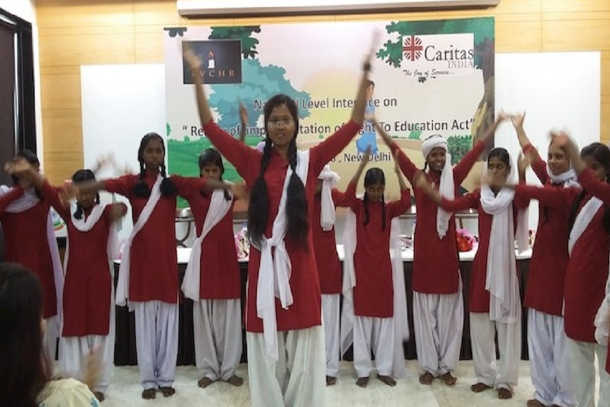
Girls from the Musahar community perform a street play in New Delhi highlighting the need to stay in school. (UCA News photo)
Church leaders and educationists have raised alarm over a survey by a parliamentary panel on education which found that over 40 percent of Indian government-run schools do not have electricity and playgrounds.
In its report tabled in the upper house, the parliamentary standing committee on human resource development (HRD) says that it is not just about electricity, playgrounds and boundary walls, noting that government schools lack infrastructure — classrooms, libraries and laboratories.
“It is a major setback for the government, which is trying to provide education for all under the Right to Education scheme, because if the infrastructure is not in place then the targeted project will not be fulfilled,” Father Joseph Manipadam, secretary of the Indian Catholic bishops' Office for Education, told UCA News.
“At least now the government is acknowledging that there is a problem and it has to solve it as soon as possible because the government has repeatedly neglected education for unknown reasons.
“Every year the government earmarks a huge amount of money for education, but unfortunately the funds do not reach the persons concerned. Most times the funds are misused or underused, but with the new findings we hope things will improve.”
Identifying the shortfalls in budgetary funding and utilization, the panel found that close to half of government schools nationwide do not have access to electricity or proper playgrounds.
The committee said budgetary allocations saw a 27 percent drop from proposals made by the School Education Department. Although a proposal for 826 billion rupees (US$11.2 billion) had been made, only 60 billion rupees were allocated.
Citing the latest survey data, the panel expressed dismay over the critical infrastructure gaps in government schools.
According to the Unified District Information System for Education survey for 2017-18, only 56 percent of schools have access to electricity, with the lowest rates in Manipur and Madhya Pradesh, where less than 20 percent have access to power.
In Odisha and Jammu and Kashmir, less than 30 percent of schools have playgrounds. In total, only 57 percent of schools across the country have playgrounds. Some 40 percent of schools do not have boundary walls to ensure the safety of pupils and school property.
The panel recommended that the HRD Ministry collaborate with the Mahatma Gandhi National Rural Employment Guarantee Scheme to construct boundary walls, and work with the Ministry of New and Renewable Energy to provide solar energy and other renewable energy sources to ensure electricity for all schools.

Musahar girls listen to the results of a survey that said educational opportunities for their community were woefully inadequate. (UCA News photo)
Dismal progress
The panel also criticized the government for its dismal rate of progress in building classrooms, labs and libraries to strengthen state-run higher secondary schools. Of the 2,613 sanctioned projects for 2019-20, the panel found only three had been completed during the first nine months of the financial year, warning that such delays will alienate students from government schools.
Although 1,021 additional classrooms had been sanctioned for the 2019-20 financial year, not even one was built during this period.
“The committee is aware of the fact that delays in completion of infrastructure not only lead to students becoming alienated from government schools but also lead to cost overruns and cause an additional strain on the financial resources of the country,” the report added.
T.K. Oommen, a Christian sociologist and former professor at Jawaharlal Nehru University, said the majority of students, especially poor ones, attend government-run schools.
"Everybody knows the sorry state of these schools and that is one of the main reasons for dropping out and lack of interest among students. But now at least the government is aware of the situation and that is a very good step," he said.
"In the last decade, the government came up with several education policies, but it failed to check malpractice in the education department.” .
The federal government launched a campaign called Beti Bachao, Beti Padhao (save the girl, educate the girl) in 2015 that aimed to generate awareness and improve welfare services intended for girls, but this project also did not see much results, he said.
“Let’s hope that after the survey the government can plug the loopholes and many students, especially poor ones, will benefit. After all, it’s the government’s duty to give free education for all.”


